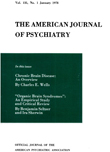THE PSYCHOPATHIC PERSONALITY
Abstract
Clinical and Rorschach studies were made on 28 soldiers evidencing a psychopathic personality. The Rorschach scatter for each of these cases is given. Three brief clinical histories are included. The total Rorschach average is given and the criminals, sexual psychopaths and paranoid personalities subtracted from this total with the Rorschach pattern of the inadequate personality given.
Certain relatively constant factors have been mentioned. It is felt that such a series under such a controlled atmosphere as produced by the military service in an overseas theatre would be difficult to duplicate in civilian life. This is a limited number of cases.
The psychopathic personality appears to be shallow, flat and lacking in sufficient inner and outer control to warrant normal behavior. The psychopath lacks adequate intellectual depth to personally understand his behavior, yet his intelligence is within normal limits as measured by clinical and psychometric appraisal. The cognitive subdivision of his personality seems rather to be ruled by primitive basic instinctual and sexual drives to the exclusion of rational behavior. There is no apparent inter-personal conflict over this apparent deviation in his integration and he continues blithely along his way, bumping his head into the stone walls of social mores and customs time and again.
Emotionally he is vacant with little innate emotional control and that present, when aroused, is characterized by violent upheavals and uncontrollable behavior of the rage reaction type which, at the time of the outburst, is of psychotic nature and appears to mimic insanity even in the legal sense of the word.
The psychopath appears to be a social misfit, usually totally unmodifiable and exhibiting a deeply ingrained disorder of temperament.
Access content
To read the fulltext, please use one of the options below to sign in or purchase access.- Personal login
- Institutional Login
- Sign in via OpenAthens
- Register for access
-
Please login/register if you wish to pair your device and check access availability.
Not a subscriber?
PsychiatryOnline subscription options offer access to the DSM-5 library, books, journals, CME, and patient resources. This all-in-one virtual library provides psychiatrists and mental health professionals with key resources for diagnosis, treatment, research, and professional development.
Need more help? PsychiatryOnline Customer Service may be reached by emailing [email protected] or by calling 800-368-5777 (in the U.S.) or 703-907-7322 (outside the U.S.).



